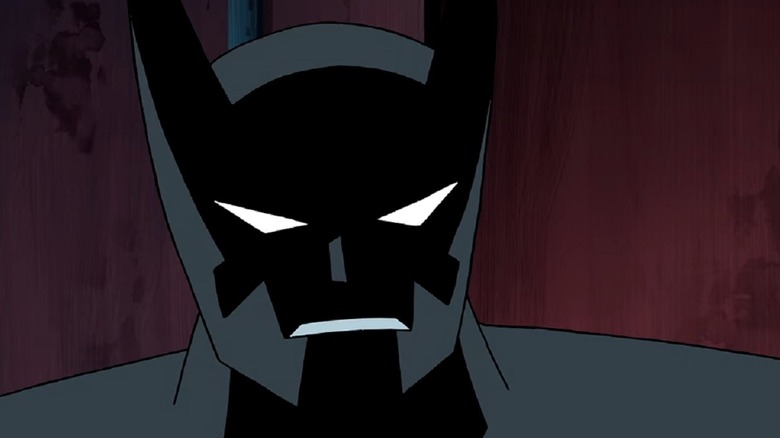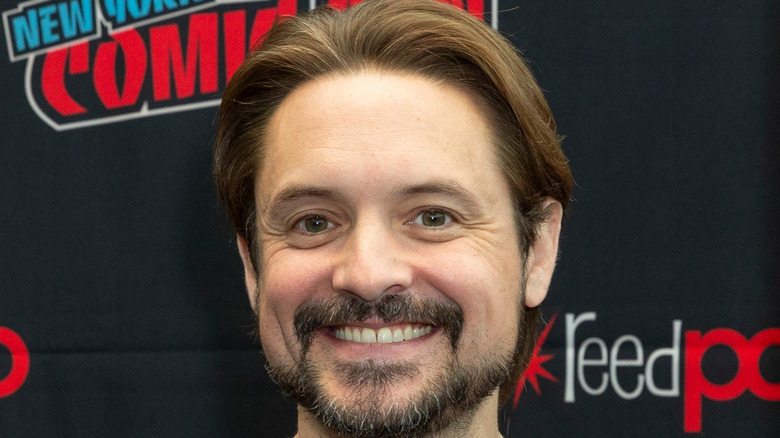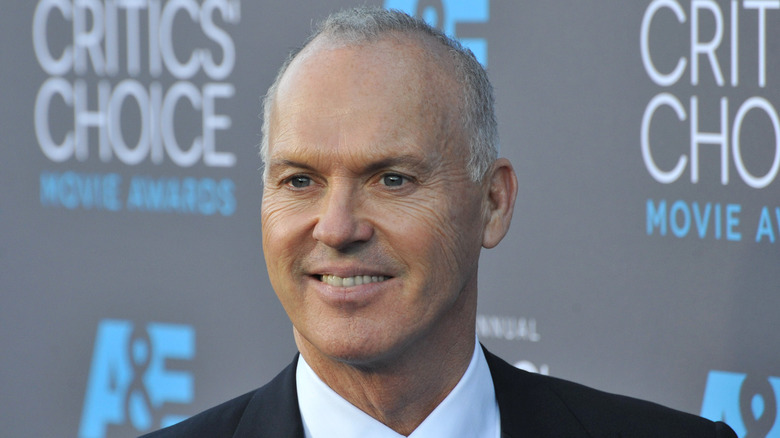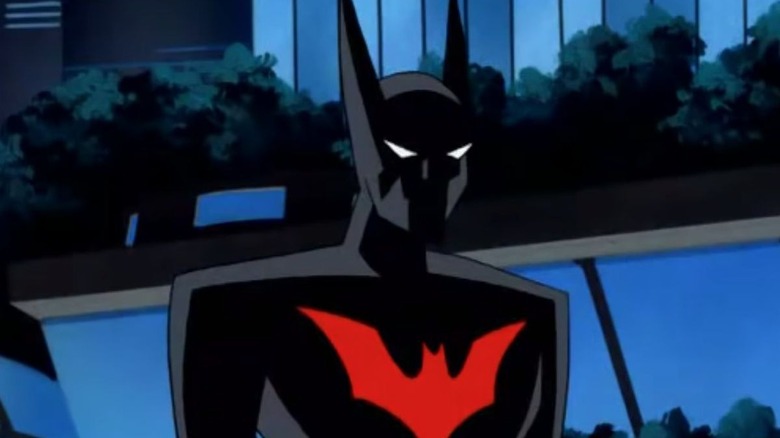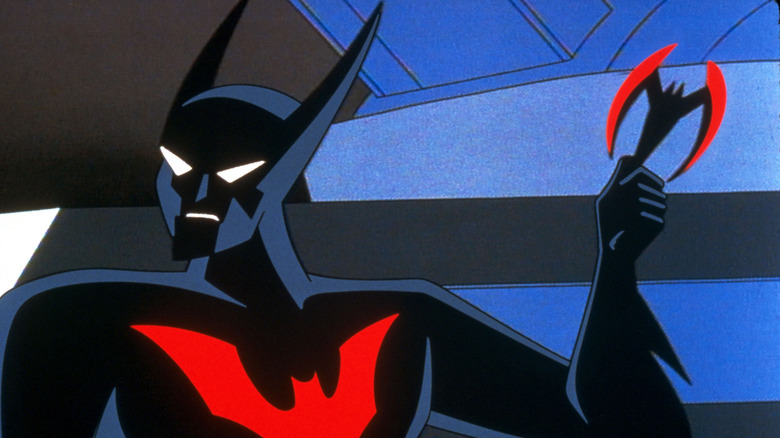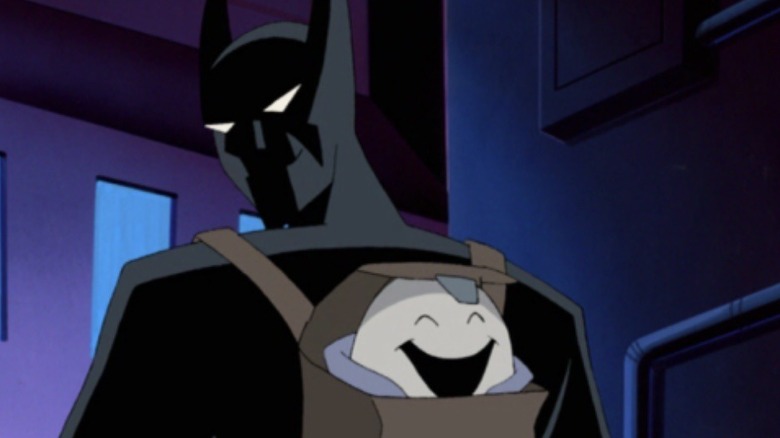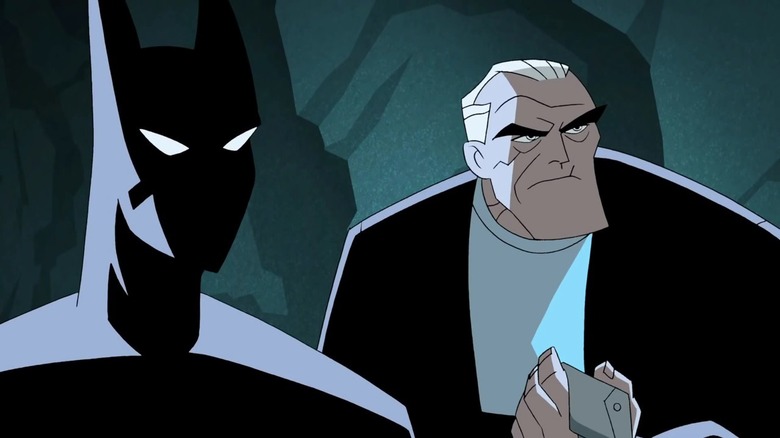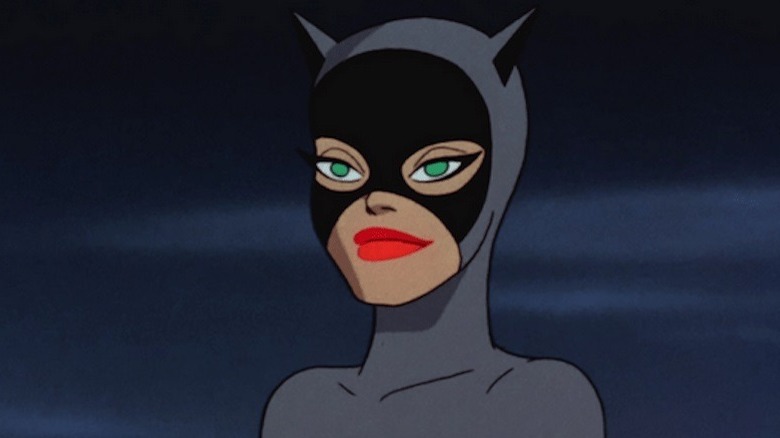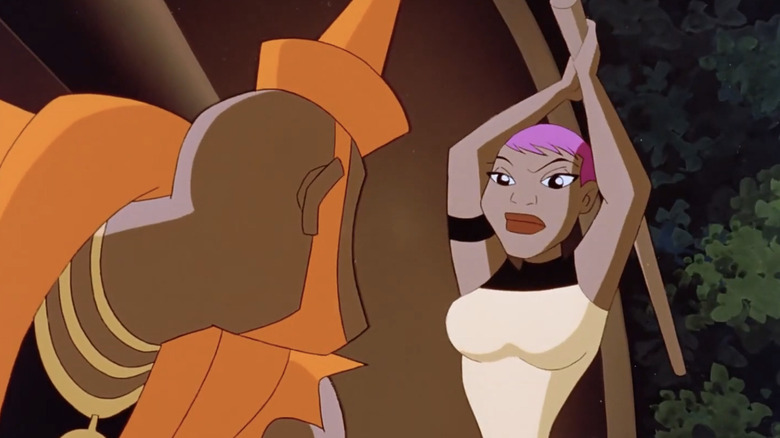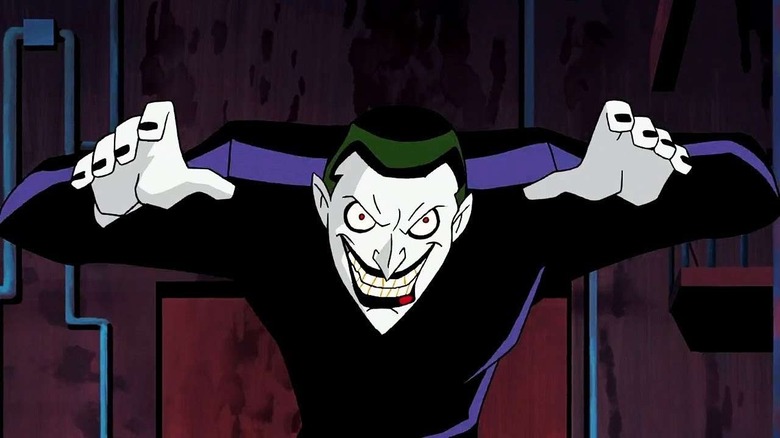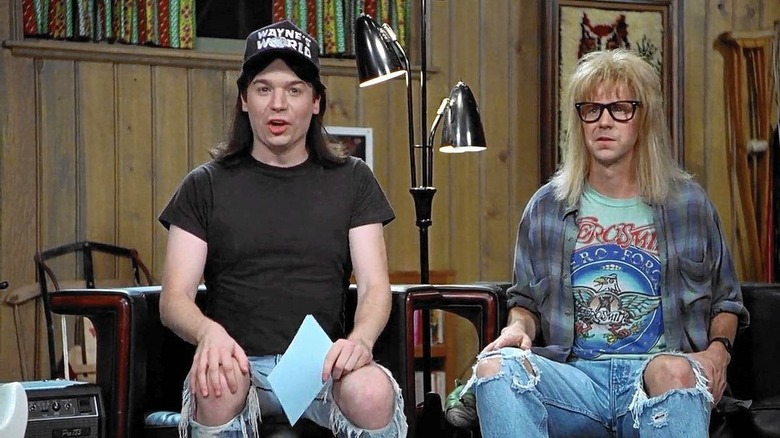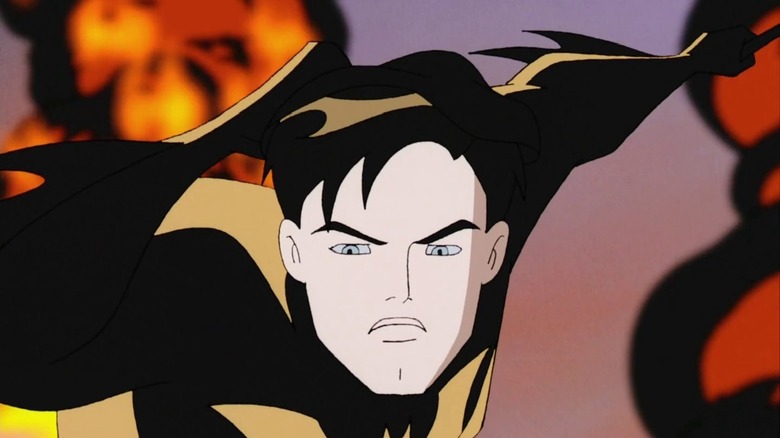The Untold Truth Of Batman Beyond
Say the words "Batman Beyond" to any fan and the first thing that comes to mind is that flashy, futuristic title sequence that sums up how this animated show is quite unlike any other. While it might've grown from the same seeds as "Batman: The Animated Series," it overcame the odds to cement Terry McGinnis — not Bruce Wayne — as the Batman of a generation.
The fact that the series still remains popular two decades after its release is a testament to its compelling take on one of the world's most famous superheroes. However, the road to Neo-Gotham wasn't paved with absolute certainty and confidence, as the show experienced its own unique set of challenges and obstacles. From the network's insistence on using certain characters to how real-world events impacted the storytelling, there were several un-schway things the cast and crew had to navigate in the process. So, let's head on down into the Batcave and uncover the untold truth of "Batman Beyond."
Bruce Timm's wife picked Will Friedle
As soon as it was decided that "Batman Beyond" would be in the same universe as "Batman: The Animated Series," it was a no-brainer that Kevin Conroy should continue as the voice of Bruce Wayne. The real question was, who would be cast as neo-hero Terry McGinnis? Considering the stature of Conroy among the fandom and industry, his co-star would need to be equally talented for the show to succeed.
During the 2019 San Diego Comic Con, series co-creator Bruce Timm revealed that McGinnis' voice was found while his wife was watching "Boy Meets World" (via Den of Geek), and suggested actor Will Friedle should be auditioned for the role. "I probably listened to at least 250 auditions for young Terry," voice casting director Andrea Romano told Flixist, "and maybe called back 50 people and Will came and I said, 'He could REALLY do it.'" Friedle was invited for a final audition alongside Conroy, and when everyone saw the natural chemistry between the two of them, it was a done deal.
Michael Keaton in a Batman Beyond movie?
It's wild to think that a property like "Batman Beyond" hasn't been turned into a live-action film yet. Seriously. Its pitch-perfect amalgamation of sci-fi, action, and superheroes is practically begging to be adapted as a blockbuster movie. And it almost happened, too. In 2000, Warner Bros. revealed that it was working on a live-action "Batman Beyond," which Boaz Yakin would've co-written and directed. Yakin even had his eye on Hollywood royalty Clint Eastwood to play Bruce Wayne, according to CBR. A year in, the studio got cold feet and put the development on ice, deciding it wanted to explore other options for Batman.
Fate has intervened here, though, affording Warner Bros. an opportunity to give the live-action "Batman Beyond" another go. With the return of Michael Keaton as the Dark Knight after three decades away, many fans are crying out for the studio to take advantage of this chance and bring the Batman of the future to the big screen now. Even Timm agrees, telling SYFY: "Honestly, I think the idea of Michael Keaton doing it is cool." Restore the Timmverse, anyone?
Will Friedle had never done voice acting before
The story of Will Friedle's journey to becoming Terry McGinnis is particularly fascinating, especially when we take into account that he'd never done any voice or animation work before "Batman Beyond." At the time of his casting, he was best known for playing Eric Matthews in the sitcom "Boy Meets World." In fact, it's almost an anomaly that he secured such a big-time voice role on his first attempt.
Friedle, though, took the opportunity with both hands, as he transformed his career with this pivotal part. While he might've started out in live-action shows and movies, he's since become a prominent voice actor. He's gone on to voice iconic characters such as Ron Stoppable in "Kim Possible," Deadpool in "Ultimate Spider-Man," Lion-O in "Thundercats," and Bumblebee in several "Transformers" productions. Friedle credits his "Batman Beyond" co-star Kevin Conroy becoming his mentor and showing him the ropes. "At first, I had no idea what to do, sitting literally slouched in front of the microphone," he explained to Den of Geek. "And Kevin's going, 'Alright, roll your shoulders back.' He mentored me in the voiceover world like Bruce Wayne."
The suits demanded Batman Beyond
If "Batman Beyond" seemed like an unexpected project when it was released, that's mostly because it was. Warner Bros. Television chief Jamie Kellner summoned Bruce Timm, Paul Dini, Alan Burnett, and then-president of Warner Bros. Animation Jean MacCurdy to tell them that the network wanted a futuristic show about a teenage Bruce Wayne (via IGN). The reason was simple: The network wanted a Batman series to appeal to a younger demographic (to sell more toys and merchandise, naturally).
Timm was devastated by the news, since the team was knee-deep in "The New Batman Adventures," and he didn't want to throw out all of the continuity and lore they'd built up to that point. So, they put their heads together and figured out a way to make this new series work without ridding themselves of all of the established stories. And presto! "Batman Beyond" was born. However, as Friedle revealed at NYCC 2019 (via Entertainment Weekly), two executives left the room after being shown the first two episodes of the show, feeling it wasn't aimed at the demographic they wanted.
The unexpected Emmy win
Going back over the show's three-season run, there were many episodes that fans could proclaim to be noteworthy examples of superior superhero television. Even the team working on the series could acknowledge that something exceptional was taking place. Director James Tucker, though, struggled to wrap his head around Season 2's Episode 19, "The Eggbaby," in which Terry McGinnis has to take a baby simulator around with him everywhere for a school project.
"It was such an unusual script that didn't really suit the tone of the show up to that point," Tucker revealed during a "Batman Beyond" anniversary panel at New York Comic Con (via Entertainment Weekly). To make matters more interesting, it was also the first episode that Tucker was set to direct, and he thought someone was setting it up as a joke. Ultimately, he wasn't quite sure what to do with something so tonally different from everything before it, so he "made it as goofy and silly" as possible. Turns out that he did well — more than well, actually — since "The Eggbaby" won an Emmy. Egg babies for the win, right?
Kevin Conroy changed his performance for Batman Beyond
Forget about Michael Keaton, Ben Affleck, Christian Bale, and Robert Pattinson for a second. When it comes to a definitive Batman that everyone can get behind, Kevin Conroy's portrayal will always shine brighter than the Bat-Signal in the sky. He isn't just the voice of Batman for a generation; he is the voice. Period. What separates Conroy from other men is that he understands what makes both Bruce Wayne and Batman tick, and can adapt that whenever necessary.
In the past, Conroy has discussed how he has tweaked his performance as the iconic hero depending on the story or medium, and the same holds true for "Batman Beyond." At the 2019 San Diego Comic-Con International (via Bleeding Cool), Conroy explained how Bruce has had to experience "the passages of time," and how his approach changed to playing the character. "He is still a powerful man, but he's frustrated by the fact that his body won't do everything he demands it to do anymore," Conroy said. "And that makes him cranky, and angry. He's angry at his body. But he is still powerful, he's still got that passion of Bruce Wayne, of Batman."
The dark Catwoman storyline that never happened
Taking into account the importance of the Bat-Cat relationship in "Batman: The Animated Series," it was surprising to see that Catwoman never featured in "Batman Beyond." Did she run out of her nine lives or what? The truth is, there were plans to bring her in, as revealed by Bruce Timm in an interview with The World's Finest. "There was this one [direct-to-video] story idea that [producer] Glen Murakami and I were toying with involving Catwoman," Timm said, "but it was pretty dark ... I mean PITCH BLACK." Unfortunately, after the controversy surrounding the "Return of the Joker" film, Timm knew it was highly unlikely that another dark movie would've been greenlit at the time.
A version of Catwoman was finally introduced in this universe in the comics; the feline fatale debuted in "Batman Beyond" #2 by Adam Beechen, Ryan Benjamin, John Stanisci, and David Baron. However, the person under the mask wasn't Selina Kyle, but rather the mysterious daughter of the villain Danton Black.
No one liked Max Gibson
Max Gibson was introduced in the second season of "Batman Beyond" as Terry McGinnis' friend and ally in his battle against crime in Neo-Gotham. She was no Robin, though, as she proudly told Terry in the Season 2 episode, "Hidden Agenda." Terry joked that she's Alfred then. But was she really?
The decision to include Max in the show wasn't made by the creators; it was taken by the network. In an interview with The World's Finest, writer Stan Berkowitz dropped the truth bomb about Max. "None of us liked the idea of including Max, but the network wanted someone girls could identify with," Berkowitz said. "She always seemed superfluous to me." He explained how Terry already had Bruce Wayne in his corner if he wanted to discuss the juggling his life as both a teenager and Batman, so there wasn't really a need for Max to fulfil this role on the show. Berkowitz added that his own feelings toward her character are clear in his writing of the episode, "Where's Terry?" He's definitely not a Max stan, that's for sure.
The displeasing Return of the Joker edits
"Batman Beyond: Return of the Joker" was a case of wrong place and wrong time. The film's release was pushed back by a few months after intense edits were ordered in the wake of the Columbine High School tragedy (per CBR). In an interview with World's Finest, series writer Paul Dini revealed that the studio tinkered with the final product until it wasn't what was initially planned anymore.
Speaking about the controversial edits, Dini said, "I don't think anyone was pleased with them, myself included. I thought it was unfortunate, and unfortunate it had that reaction. It upset me for a number of reasons because we just had done our job." Dini admitted that he felt professional disappointment over what happened, and he didn't think the level of violence in the film's original cut was anything different than what DC Comics was doing at the time. An uncut version of "Return of the Joker" was eventually released in 2002, but "Batman Beyond" had already been canceled by then.
Wayne's World influenced the show's dialogue
"Batman Beyond" takes place in 2039, when Neo-Gotham is this futuristic city filled with cutting-edge innovation and new, edgy lingo. Much like "Back to the Future," it's hilarious to see the future that the writers envisioned, considering how hoverboards are still nowhere to be found and humanity's most significant innovation of the past two decades is meme culture. Still, it's interesting to see how phrases like "dreg" and "schway" came to be, since they sound more like glorious names for emo or post-hardcore bands than everyday words.
The origin of these terms can be traced back to a seminal comedy film from 1992, as revealed at the 20th anniversary of "Batman Beyond" panel at San Diego Comic Con in 2019. Writer Hilary J. Bader would parody words such as "schwing" from "Wayne's World," and fellow writer Bob Goodman's wife thought "schway" actually sounded like a pretty good synonym for "cool." Unlike "fetch," we'd still love to try and make "schway" happen, and become acknowledged by Grammarly.
Will Friedle's sad last day
What most fans don't realize is that Will Friedle pulled a double shift during the production of "Batman Beyond." As he revealed at SDCC 2019, he'd record the animated show on a Thursday morning, then head off to film "Boy Meets World" in the evening. Undoubtedly, this must've been a grueling schedule, as he'd need to shift his mindset for the respective series, but it was made even worse on one specific day.
"The last episode of 'Batman Beyond' recorded in the morning that the last episode of 'Boy Meets World' filmed," Friedle said. "So both of my shows ended on exactly the same Thursday." While he would've been well-aware that both shows were coming to an end, that still doesn't soften the blow. At least he's been able to reprise both roles since then, in a "Batman Beyond" short and "Girl Meets World," so it wasn't quite the final goodbye he might've expected at the time.
Overcoming the fan hate
If we've learnt anything about fandom, it's that it doesn't like change. When the news first broke that "Batman Beyond" was entering production, and there would be a new character taking on the mantle of the Dark Knight, there was predictable outrage. It was a different time, though, so the outraged weren't able to review-bomb Rotten Tomatoes, or send hateful tweets to the cast and crew. Instead, their ire had to be contained in the letters section of magazines, or on old-school message boards.
Discussing the initial heat surrounding the series at San Diego Comic Con in 2019, series co-creator Glen Murakami said, "I feel like that every single show they hate in the beginning and then when it's gone they love it." He was completely right, because once the show aired, the fan sentiment started to shift as everyone understood "Batman Beyond" wasn't trying to erase everything before but rather to build upon it. Ah, if only a wait-and-see energy could be applied to every production.
